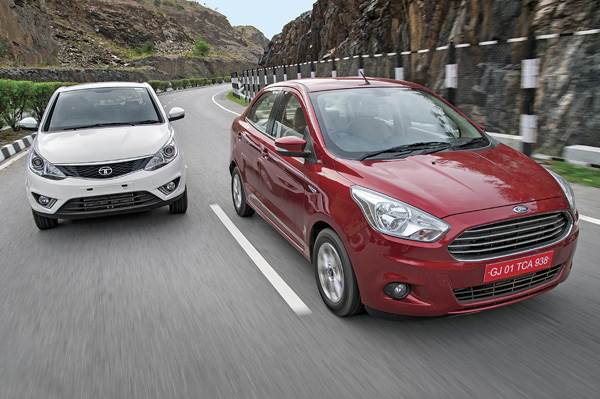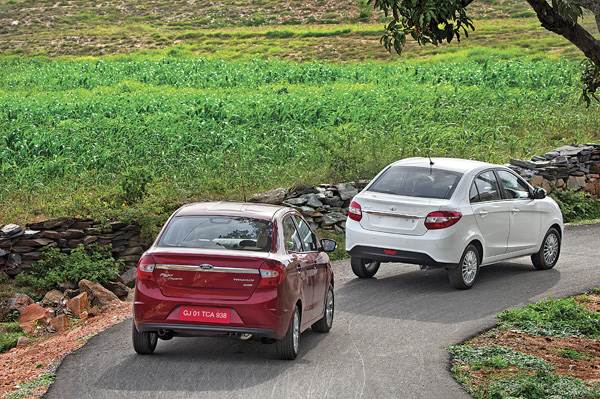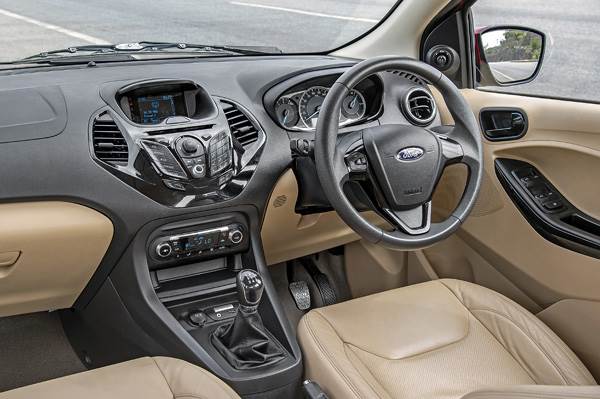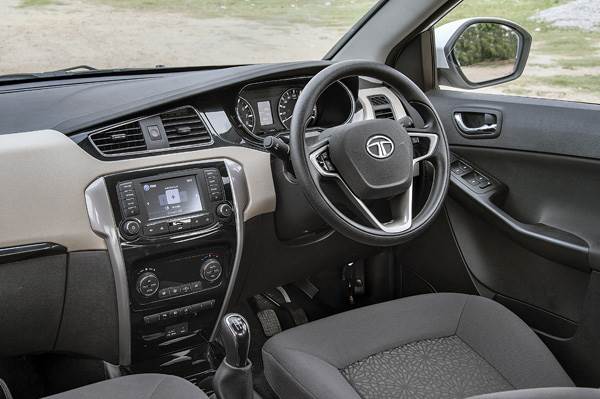With its combination of a highway-friendly diesel engine, superb ride quality, and comfy and feature-loaded cabin, the Tata Zest has so far come across as the most-rounded compact sedan; one that offers everything a typical high-mileage diesel car buyer would want. Trouble for the Zest is, the new Ford Figo Aspire diesel’s list of strengths aren’t too different from its own. To sort out this diesel dilemma, we’ve brought the Tata and Ford together. Can the new Ford aspire to better the Zest to become the best?

Let’s give this comparison a rolling start by seeing how this duo fare against one another on the move. Well, the Figo comes into the fight with a displacement, power and weight advantage. Its 1.5-litre diesel engine makes 99bhp and 21.9kgm, and has to move all of 1,048kg. The Zest’s Fiat-sourced 1.3 turbo, on the other hand, produces 89bhp and 20.4kgm, while the car weighs in at a heavier 1,155kg. Unsurprisingly, the Figo is the quicker car here. But what is more telling is the margin by which it is quicker than the Zest, be it in the 0-100kph dash or through the gears. Thing is where the Zest’s engine comes alive only after overcoming the low rpm weakness it is universally known for, the Figo’s engine delivers strong pulling power from shortly after idle. In city traffic, there’s a big difference in the driving experience when you have access to power at 1,400rpm, as in the Figo’s case, versus when power comes in earnest only at about 2,000rpm, as on the Zest; there’s noticeably less need to shuffle through the gears in the Figo to keep pace with intermittent traffic. Both cars do have reasonably nice gearboxes but the Zest’s clutch is lighter. And while neither engine is particularly quiet, the Tata’s is the quieter of the two at city speeds. Out on the highway, once again, it’s the Figo’s engine that feels more responsive with a wider powerband to operate in. Not to say that the Zest’s motor is completely overshadowed here. Keep revs above 2000rpm and the engine will give sufficient punch to allow you to overtake other vehicles with ease.
If not for performance, the Tata Zest does hold its own for ride quality. Yes, the Ford Figo Aspire is very absorbent and pliant in its own right, but the Zest’s ride quality is at another level. The car simply seems unfazed by the worst of our roads with little noise coming out of the suspension system either. The Zest’s 15-inch tyres also round off the potholes more successfully than the Figo’s 14-inchers. The big surprise is that even at higher speeds, it’s the Zest that feels the more sure-footed; the Ford tends to move around more. On a ghat road, you’ll find the Figo to be marginally more agile and perhaps a bit more nimble in the city too but for sheer steering feel, it just can’t beat the Zest.
See the two at a parking lot and you’ll note both have attractive faces but generally awkward proportions — their respective truncated tails are to blame here. Boot space is also comparable and down on the segment bests. That said, the Zest’s greater height (1,570mm to the Figo’s 1,525mm) and marginally wider body (1,706mm vs 1,695mm) makes it look the more substantial of the two. The Tata promises greater cabin space as well.

On first look, the rear portion of the Zest’s relatively high-set cabin does seem larger. It’s wide as compact sedan cabins go, offers enough by way of headroom and also has large windows that let in lots of light. But, surprisingly, there’s similar space in the Figo as well, at least talking head and legroom. Yes, the Figo does have the longer wheelbase, but what really makes the cabin feel larger than it appears is the clever packaging. What’s also special here is rear seat comfort. Our top-spec Figo Titanium+’s leather seats have just the right amount of cushioning to keep occupants comfy over long distances. The well-positioned centre armrest (a feature not available on the Zest) also adds much to comfort. Still, the Figo’s rear seat won’t be able to host three as well as the Zest’s wide and sofa-like rear bench can. The Zest’s rear seat is on the softer side though and that’s true about the large front seats as well. Moreover, the Zest’s narrow footwell doesn’t give the driver sufficient place to stretch their left leg when out cruising, and the steering feels a bit high even at its lowest setting.
But, it’s also from the Zest’s driver’s seat that you’ll see and experience the best of the Tata. The chunky steering is great to hold, there’s a certain richness to the dials and the whole dash looks very modern courtesy the 5-inch touchscreen infotainment system. The system does catch a lot of glare but it is nice enough to use for basic functions such as phone operation and music streaming. What’s also nice is that the larger bits of the cabin come finished in smart-looking plastics. Still, there are plenty of tacky surfaces too and also a frustrating lack of cup/bottleholders and storage recesses in the Zest.
The Figo’s cabin is better thought out in that sense. Not only does it have more space for odds and ends but the driving position is easier to adjust and the footwell has more space too (but no dead pedal). And like the rear seats, the Figo’s front ones score better than the Zest’s on comfort too. But it’s not all rosy in the Figo’s cabin either, interesting dashboard design notwithstanding. Plastic quality, for one, is a mixed bag and just on par with the Zest’s. Few people are likely to fall for the Figo’s small and sticker-like instruments too. Also, after having a go with the Zest’s touchscreen infotainment system, the Figo’s button controlled unit doesn’t seem as modern. The Titanium+ version’s unit does offer plenty by way of functionality though. In addition to Bluetooth connectivity, it will also link up to a few mobile apps and is also programmed to automatically alert concerned authorities in case of an accident. What’s commendable is that the Titanium+ Aspire gets as many as six airbags to the top-spec Zest XTA’s two.

Then again, you will pay a lot more for the Figo Aspire. In true Tata fashion, the Zest gives more car per car. But taking everything into account, it’s still the Ford Figo Aspire that gets our vote. True, the Figo doesn’t have a touchscreen, it’s cabin won’t accommodate five as easily as the Tata and its ride quality is also not quite as accomplished as the Zest’s. But the fact is neither point is a deal breaker. The Ford’s infotainment system is good enough, and if you factor in the seats, the Figo’s overall comfort is actually better than the Zest’s. The Ford’s cabin is also more user-friendly but more than anything else, it’s the Ford’s fantastic engine that really seals it for the Aspire. Not only is it better suited to city and highway use than the Zest’s unit, ARAI-tested fuel economy figures suggest it’s more efficient too. In all, the Ford is the better car to own and drive and the one we’d buy.







Comments
Member Login
Personal Details
No comments yet. Be the first to comment.